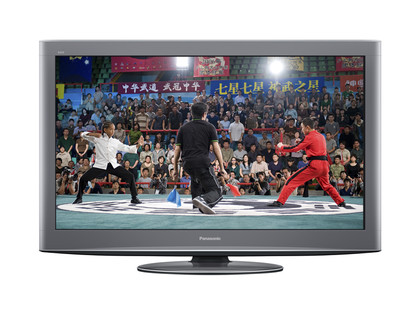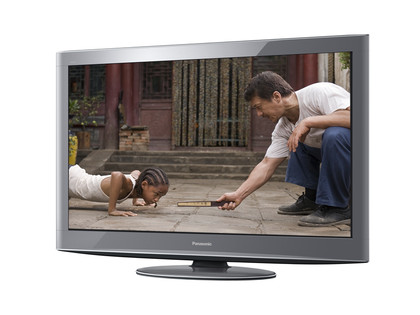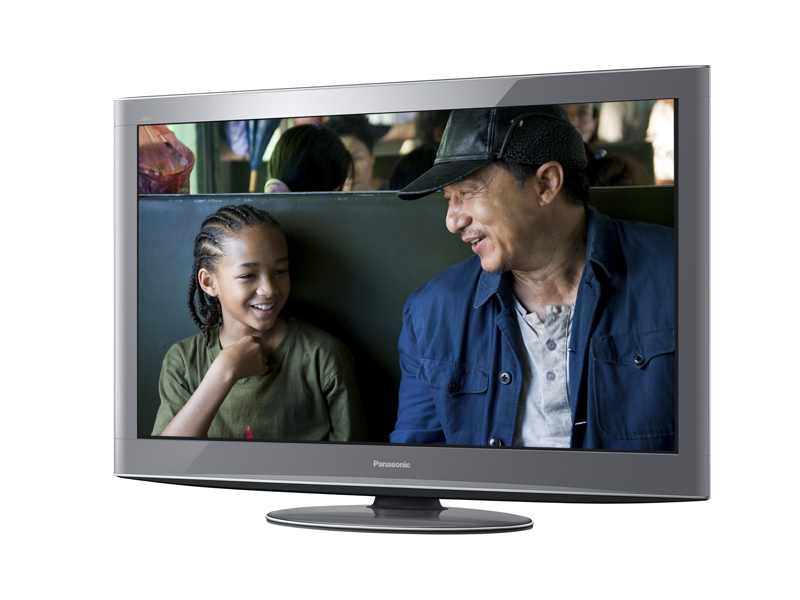Why you can trust TechRadar

As suggested in the Overview section, the key thing about the V20 series is its use of Infinite Black Pro technology. This drives the key High Contrast Filter component harder to deliver richer, deeper, and more consistent black shades, thereby helping the all-important contrast performance.
The fact that the P42V20 ships with a USB dongle enabling it for Wi-Fi integration with your home network is also an advantage over the step-down G20 series, though it's a pity that Panasonic couldn't manage to build its wireless abilities into the main TV chassis like Philips and Sony have with some of their current high-end models.
The V20's three speakers, meanwhile, are arranged in an interesting 2.1 configuration, versus the usual two-channel approach sported by the step-down G20 series.
Given that making the V20 Wi-Fi requires the use of a USB dongle, it's good to find the P42V20's connections including two USB inputs, so that one is free for multimedia duties include playing back photo, audio and video files from storage devices, and recording broadcasts from the set's built-in HD tuners to USB hard-disk drive (HDD).
Our efforts so far, though, have found that only the Buffalo JustStore Desktop HD-EU2-UK USB HDDs – as recommended by Panasonic – seem to 'handshake' properly for recording.
Twin tuner
The eagle-eyed among you will have noticed that we referred to 'HD tuners' a couple of paragraphs ago. This wasn't a typo: the P42V20 joins other mid-to-high-end Panasonic TVs this year in sporting both Freeview HD and Freesat HD tuners.
No other brand that we're aware of is offering comparable HD broadcast support, with the combination of terrestrial and satellite options ensuring that you'll be able to receive free hi-def programming wherever you live in the UK.
Other connections of the P42V20 point toward further interesting features. There's a single HDMI v1.4 input alongside three v1.3s, for instance, which enables the audio return channel function permitted by the v1.4 spec. Just to be clear, the v1.4 input does not offer any 3D capability.

Then there's the Ethernet port. Now a pretty much universal feature on high-end TVs since it was made part of the Freeview HD/Freesat HD spec, the one on the P42V20 does way more than just provide access to whatever interactive features the free-to-air HD broadcasters might send your way.
For a start, it also enables you to access and stream files stored on a PC, provided that PC has a DLNA function. But also enables Panasonic's ring-fenced Viera Cast internet browsing system.
After falling rather behind the recent online offerings of Samsung and Sony, Panasonic has closed the gap a little by adding the movie purchase/rental service AceTrax to its platform. This enables you to store stuff you've bought or rented on an online 'cloud' for streaming into your TV when you feel like watching it.
There's Skype support, too, as well as Eurosport news, YouTube, Picasa, DailyMotion and a weather channel. None of which lifts Panasonic into the premier league of online service providers, but it's a lot better than nothing and Panasonic deserves further credit for its extremely usable web interface.
Panasonic has been strangely reluctant to furnish its TVs with extensive calibration tools in the past, but the P42V20 bucks this trend with a passably flexible colour management system and a degree of gamma control.
The fine-tuning options are now sufficient for third-party endorsement from both THX and the Imaging Science Foundation, the latter ensuring that you can arrange for an ISF expert to calibrate the TV if you wish – something we'd strongly recommend.
The extensive feature list also includes a full HD panel resolution, which is quite important considering no other plasma manufacturer has managed to fit 1,920 x 1,080 plasma cells into a 42in screen.
Elsewhere, Panasonic's 600Hz Sub-Field drive system, is on hand to reduce judder and enhance stability, while a Resolution Enhancer does a very respectable job of upscaling standard definition, provided you use it on its lowest setting.
One last point worth covering is that the V20 doesn't feature the fast plasma cell decay technology featured in the VT20 series, arguably because it doesn't really need it given that its pictures aren't having to keep up with the demands of the sequential frame 3D format.
Current page: Panasonic TX-P42V20: Features
Prev Page Panasonic TX-P42V20: Overview Next Page Panasonic TX-P42V20: Ease of useJohn has been writing about home entertainment technology for more than two decades - an especially impressive feat considering he still claims to only be 35 years old (yeah, right). In that time he’s reviewed hundreds if not thousands of TVs, projectors and speakers, and spent frankly far too long sitting by himself in a dark room.

